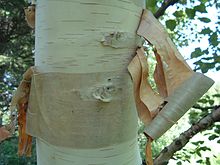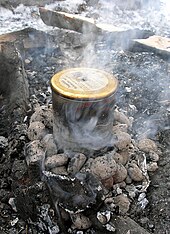Birch bark

As a birch bark soft and pliable is bark of birch called, she found earlier one multiple uses. However, the bark of the birch trees that grow in Central Europe cannot be peeled off in large pieces as easily as that of the birch trees in the Swedish, Finnish, Russian and North American taiga .
Fuel
Birch bark and birch cork are flammable even when they are moist because they contain essential oils . Fine strips of birch bark can be used as tinder . Birch bark can be used to make simple torches that burn for around 2 minutes.
adhesive
Already in the Paleolithic Age , for around 400,000 years, Homo heidelbergensis , and later also Neanderthals and Homo sapiens , used heated and polymerized components of the birch sap from birch bark in the form of birch pitch as an adhesive , especially for stocks . Birch pitch was also used in the Mesolithic. Usable amounts of birch pitch can be made by burning birch bark near stone or bone surfaces. The birch pitch can then be scraped off the surfaces.
Building material
Birch bark was used to cover huts and roofs, also for wigwams in North America, and as a base for sleepers and beams.
Some Indian tribes in Canada built or build canoes from birch bark, such as the Anishinabe and the extinct Beothuk .
Due to the long-lasting soft and pliable properties of the bark, baskets , tobacco boxes and much more are made from it. In the Scandinavian countries , Russia and Finland , shoes, rucksacks, clothing, covers for glass bottles, knife sheaths and horns were made from birch bark. The birch bark was made elastic by special and traditional methods and used for lamination or for covering arches. This method was popular in the Slavic culture to protect their composite bows from the elements. Larger birch bark plates could also be made into quivers, for example the Hungarian stand-by quiver or the Slavic birch bark quiver. Smaller pieces or leftovers can be processed into (knife) handles.
Roof covering with birch bark ( Moragården )
Birch bark canoe
Insulation material
Because of the insulating properties of the cork, mats were used as sleeping pads in a variety of ways, for example from the Mesolithic . B. proven at the Duvensee site .
nutrition
The cambium , the lower layer of the birch bark, is edible and contains, among other things, the sugar alcohol xylitol .
medicine
Thin birch bark can be used as a bandage . Birch bark has been used as a natural remedy since the Middle Ages.
The tri terpenes contained in the birch bark , including betulin in particular , are beneficial for wound healing . They serve the plant to ward off pests and to protect against UV radiation and are bactericidal , along with other ingredients. In addition, antiviral effects have been recognized, for example against HIV . Efficacy against malaria and tumors has also been shown.
In January 2016, the European Commission granted the betulin-containing drug Episalvan European approval for the treatment of dermal wounds in adults.
Writing material
Birch bark has been used as a writing material in various parts of the world . From Novgorod are birchbark texts received, a collection of over 1000 texts on birch bark from the 11th to 15th centuries. This includes the birch bark text No. 292 , the oldest known document in a Baltic Finnish language .
In the Indian cultural area, birch bark was mainly used in the Himalayan region, where the Himalayan birch ( Betula utilis ) occurs. Some of the oldest surviving Indian manuscripts are written on birch bark, such as the Buddhist manuscripts dating from the 1st century BC. And the 2nd century AD in Gandhara . The Bakhshali manuscript , which may contain the oldest evidence for the use of the number zero, is also written on birch bark. References to writing on birch bark can also be found in literary sources. The poet Kalidasa has the protagonist Urvashi write on a piece of birch bark in his drama Vikramorvashiya . The same author describes in his art epic Kumarasambhava how the Vidyadharas (demigods) in the Himalayan mountains use birch bark to write love letters. Birch bark remained in use as writing material among the Hindus in Kashmir until the 18th century.
art
Today birch bark is mainly used for objects of the arts and crafts, such as storage containers ( tujes ), caskets , boxes , jewelry and others. The surface of the birch bark is ideal for painting with Indian ink or acrylic paint. In traditional Russian art there are ink drawings that include the natural adhesions in the painting. Boxes or Tujes are u. a. decorated with "Mesenskaya Rospis".
The natural birch bark can be hung like a picture or a collage. The white color of the bark is caused by the embedded pentacyclic triterpene betulin.
literature
- Semyenova Maria (2007). "We-Slavs". St. Petersburg: Asbuka-Klassika
- C. Ted Behne (Ed.): The Travel Journals of Tappan Adney, 1887-1890. Estate of Tappan Adney, 2010.
Web links
Individual evidence
- ^ Emil Hoffmann: Lexicon of the Stone Age . Verlag CH Beck, Munich 1999, ISBN 3-406-42125-3 , pp. 123 f., 330.
- ^ Müller-Karpe : Handbook of Prehistory. Volume I: Paleolithic. , CH Beck Verlag, Munich 1966, p. 38 f.
- ^ EM Aveling, C. Heron: Identification of birch bark tar at the Mesolithic site of Star Carr. In: Ancient Biomolecules . Volume 2, No. 1, 1998, pp. 69-80.
- ↑ Schmidt, P., Blessing, M., Rageot, M., Iovita, R., Pfleging, J., Nickel, KG; Righetti, L. & Tennie, C .: Birch tar extraction does not prove Neanderthal behavioral complexity . In: PNAS . August 19, 2019, doi : 10.1073 / pnas.1911137116 .
- ↑ a b Tom Vennum, Charles Weber, Earl Nyholm: Earl's Canoe: A Traditional Ojibwe Craft. Smithsonian Center for Folklife Programs and Cultural Studies.
- ^ John McPhee: The Survival of the Bark Canoe , Farrar, Straus and Giroux, New York 1975.
- ^ Edwin Tappan Adney, Howard Chapelle: Bark Canoes and Skin Boats of North America. Skyhorse Publishing Inc., 2007, 2014.
- ^ John Jennings: Bark Canoes: The Art and Obsession of Tappan Adney. Firefly Books Ltd., 2004.
- ^ FW Goode, Ojibwe: Birch Bark Canoes: Anishinaabe Wigwassi-Jiimaan, Beaver Bark Canoes. 2012.
- ↑ Sami Alakurtti, Taru Mäkelä, Salme Koskimies, Jari Yli-Kauhaluoma: Pharmacological properties of the ubiquitous natural product betulin. In: European journal of pharmaceutical sciences . Volume 29, No. 1, 2006, pp. 1-13, doi : 10.1016 / j.ejps.2006.04.006 .
- ↑ Birch trees work - Researchers are studying the healing properties of extracts from the birch bark. In: Pflanzenforschung.de. Retrieved January 3, 2015 .
- ↑ Sandra Ebeling, Katrin Naumann, Simone Pollok, Tina Wardecki, Sabine Vidal-y-Sy, Juliana M. Nascimento, Melanie Boerries, Gudula Schmidt, Johanna M. Brandner, Irmgard Merfort: From a traditional medicinal plant to a rational drug: Understanding the clinically proven wound healing efficacy of birch bark extract. In: PLoSOne . Volume 9, No. 1, January 22, 2014, doi : 10.1371 / journal.pone.0086147 .
- ↑ Jiří Patočka: Biologically active pentacyclic triterpenes and their current medicine signification. (PDF) In: J Appl Biomed. Volume 1, No. 1, 2003, pp. 7-12.
- ↑ Kemal Duric, Elvira Kovac-Besovic, Haris Niksic, Emin Sofic: Antibacterial activity of methanolic extracts, decoction and isolated triterpene products from different parts of birch, Betula pendula, Roth. In: Journal of Plant Studies . Volume 2, No. 2, 2013, pp. 61-70.
- ↑ S. Cı̂ntă Pı̂nzaru, N. Leopold, W. Kiefer: Vibrational spectroscopy of betulinic acid HIV inhibitor and of its birch bark natural source. In: Talanta . Volume 57, No. 4, 2002, pp. 625-631, doi : 10.1016 / S0039-9140 (02) 00102-9 .
- ^ S. Alakurtti, T. Mäkelä, S. Koskimies, J. Yli-Kauhaluoma: Pharmacological properties of the ubiquitous natural product betulin. In: European journal of pharmaceutical sciences. Volume 29, Number 1, September 2006, pp. 1-13, doi : 10.1016 / j.ejps.2006.04.006 .
- ↑ SK Krol, M. Kiełbus, A. Rivero-Müller, A. Stepulak: Comprehensive review on betulin as a potent anticancer agent. In: BioMed research international. Volume 2015, 2015, p. 584189, doi : 10.1155 / 2015/584189 , PMID 25866796 , PMC 4383233 (free full text).
- ↑ SC Jonnalagadda, MA Corsello, CE Sleet: Betulin-betulinic acid natural product based analogs as anti-cancer agents. In: Anti-Cancer Agents in Medicinal Chemistry . Volume 13, Number 10, December 2013, pp. 1477-1499, PMID 23848199 .
- ↑ European Commission grants marketing authorization for Episalvan ( Memento of the original from January 25, 2016 in the Internet Archive ) Info: The archive link was automatically inserted and not yet checked. Please check the original and archive link according to the instructions and then remove this notice. , PM Birken AG of January 22, 2016
- ↑ Stefan Baums: "Gandhāran Scrolls: Rediscovering an Ancient Manuscript Type", in: Jörg B. Quenzer, Dmitry Bondarev, Jan-Ulrich Sobisch (eds.): Manuscript Cultures: Mapping the Field, Berlin / Munich / Boston: De Gruyter, 2014, pp. 183–225, doi: 10.1515 / 9783110225631.183 .
- ↑ Harry Falk: Writing in ancient India. A research report with annotations. Tübingen: Gunter Narr Verlag, 1993, p. 310.
- ↑ Jeremiah P. Losty: The Art of the Book in India. The British Library Publishing Division, 1982, p. 8.









